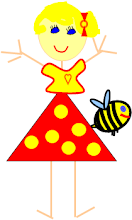Set out a piece of paper and some crayons and see the growth and development that is taking place.
Fine motor skills are being strenthened as preschoolers grasp the crayons and hold on tight enough to make the color show up on their paper.
Eye-hand coordination is challenged as preschoolers learn to use the crayons to draw long connected or short curly lines.
The imagination is sparked as children create what may seem like scribbles to the untrained eye but to the child it may be a house, baby, or the family dog.
Color recognition is being reinforced as preschoolers choose among the many different color choices made available to them.
Communication skills are encouraged as preschoolers are asked to share something about their drawings with the class.
 Keep crayons and paper available in your classroom all throughout the day and give your students time to color.
Keep crayons and paper available in your classroom all throughout the day and give your students time to color.Younger preschoolers need time to strenthen their abilities and as they get older, they will be better able to master the skill of coloring and drawing.



7 comments:
I host a weekly Open Ended Art Blog Linky Meme on my blog if your interested check it out: http://lettersnumbersandbooksohmy.blogspot.com/search/label/Open%20Ended%20Art
I checked out your blog - very nice!
This is a great blog! I am making a handout for child care teachers about this very topic. Can I use your picutures and points? I added some information and one point to them below...
2.Eye-hand coordination is challenged as preschoolers learn to use the crayons to draw long connected or short curly lines. Allow them use crayons on paper at the easel too. The different angle refines a whole different set of fine motor muscles.
3.The imagination is sparked as children create what may seem like scribbles to the untrained eye but to the child it may be a house, baby, or the family dog. The art never has to “be” something. Young children enjoy and learn from the process not the product.
4.Color recognition is being reinforced as preschoolers choose among the many different color choices made available to them.
5.Communication skills are encouraged as preschoolers are asked to share something about their drawings with you or the class. Ask the child if you can write on their creation. If yes, dictate on the art whatever the child says to describe it. This allows the child to start realizing that letters mean something and helps the parent start a conversation with a child then extending the language development opportunities.
6. Display the creations in an art gallery at the child’s eye-level. Allow the child to pick which creation is displayed. Children then get the experience in making decisions and it fosters the child’s self-esteem when they are proud of what they make.
Those are wonderful points to add, thank you for sharing them with us and yes, feel free to use my information and pictures for your handout.
What do you think about using markers in Pre- K?
Is it developmentally appropriate , or does one always use broken crayons to work on grip?
Hi Pam,
I think in pre-k it is acceptable to allow students to use all types of writing materials. Markers, crayons, and pencils all bring value to their growth and development. Using markers still helps promote eye-hand coordination as well as creativity and imagination - plus students like it and we do want writing and drawing to be appealing and fun. I would make sure your students are using a variety of writing tools so they can perfect their skills and have fun in the process.
Couldn't agree more. I have found in some environments some teachers are reluctant to have them readily available because they don't want to supervise the area. Your explanation is right on point.
Post a Comment